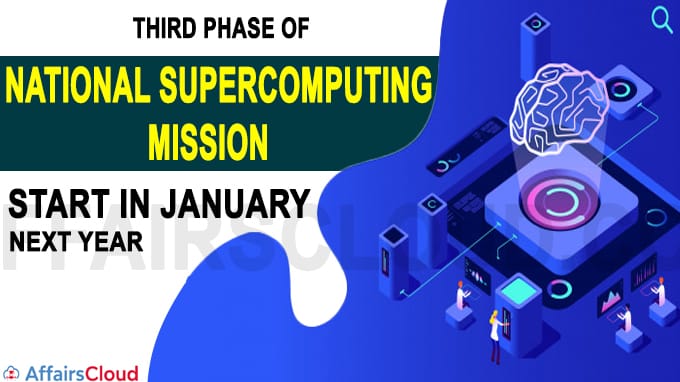 The Department of Science and Technology (DST), under the Ministry of Science and Technology has stated that the Third Phase of the National Supercomputing Mission (NSM) will commence from January, 2021. This phase will take the computing speed to 45 Petaflops (PF).
The Department of Science and Technology (DST), under the Ministry of Science and Technology has stated that the Third Phase of the National Supercomputing Mission (NSM) will commence from January, 2021. This phase will take the computing speed to 45 Petaflops (PF).
The works on Phase Three will include Three systems of 3 PF each and one system of 20 PF as a national facility.
Key points:
i.NSM is boosting High-Performance Computing (HPC) to meet the increasing demands of academia, researchers, medium small and micro enterprises and start-ups like oil exploration, flood prediction, Genomics and Drug Discovery.
ii.NSM with total outlay of Rs.4500 Crore is expecting to start around 50 Supercomputers across the country in Three Phases.
Three Phases of NSM:
i.The Three phases will provide access to HPC facilities to 75 institutions, academicians working through Nation Knowledge Network (NKN), which is the backbone for supercomputing systems.
ii.Much of the Infrastructure planned in NSM phase I has been installed and Phase II works are ongoing, the speed of supercomputers in the country will soon reach 16 PF.
iii.The Phase II installations will be completed by April 2021; 8 institutions will be equipped with supercomputing facilities before the deadlines.
Memorandum of Understanding (MoU):
i.MoU has been signed with 14 Premier institutions of India to establish Supercomputing Infrastructure with Assembly and Manufacturing in India.
ii.The list includes Indian Institute of Technology (IITs), National Institute of Technology (NIT), National Labs, and Indian Institutes of Science Education and Research (IISER).
Indigenous Supercomputers:
i.Param Shivay is the first supercomputer to be assembled indigenously, it was installed in IIT (BHU) Varanasi, followed by Param Shakti at IIT-Kharagpur, and Param Brahma at IISER, Pune.
Artificial Intelligence (AI):
In order to handle large-scale AI workloads and increase the speed of computing-related to AI, 100 AI PF Artificial Intelligence supercomputing systems are being created and installed in C-DAC (Centre for Development of Advanced Computing).
Indigenous capability:
i.NSM is scaling up technology and manufacturing capability to manufacture more parts in India.
ii.In Phase-I, 30 % Value Addition was done in India, and it has been scaled up to 40 % in Phase-II.
iii.Efforts are being made to increase design and development of parts like server board, interconnect, processor, system software libraries, storage, and HPC-AI converged accelerator domestically.
iv.Systems which have been designed and manufactured in India will be installed at places like IIT-Mumbai, IIT-Chennai, and Inter-University Accelerator Centre (IUAC) at Delhi, C-DAC-Pune which are covered under Phase-III. It will pave the way for achieving self-reliance in the field.
Indigenous Server (Rudra):
i.India has also developed Indigenous Server (Rudra) to meet HPC requirements of Governments and Public Sector Undertakings (PSUs).
ii.It is the first time that a server system was made in India with Full Software stack developed by C-DAC.
National Supercomputing Mission (NSM):
i.NSM was announced by the Ministry of Electronics and IT (MeitY) and DST in 2015.
ii.It is implemented by C-DAC, Pune and Indian Institute of Science (IISc), Bengaluru.
Recent Related News:
i.On 18th August 2020, Ravi Shankar Prasad, Union Minister of Law & Justice, Communications and Electronics & Information Technology launched the “Swadeshi Microprocessor Challenge- Innovate Solutions for #Aatmanirbhar Bharat”.
ii.July 3, 2020 Ramesh Pokhriyal ‘Nishank’, Union Minister of Human Resource Development and Dr. Harsh Vardhan, Union Minister for Health and Family Welfare and minister of Science and Technology launched the Drug Discovery Hackathon (DDH2020)
About Ministry of Science and Technology:
Union Minister– Harsh Vardhan
Departments under the ministry– Department of Science & Technology(DST), Department of Biotechnology(DBT), Department of Scientific & Industrial Research(DSIR)




